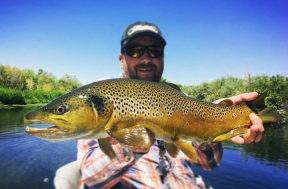
What I didn’t like about 2016 was that early on we got fooled into thinking we had a good strong snowpack. In March it was sitting at or just above normal. Unfortunately, above normal temperatures and moisture took it all away. What moisture we had was rain instead of snow. The result was almost the opposite of what we expected 2016 to be. Instead of a strong salmonfly hatch on the Henry’s Fork, the water was too low for trout to hold comfortably on the banks. The Lower Henry’s Fork always gets pounded in late May and early June. It doesn’t take many boats to chase the fish off the banks. The hatch wasn’t bad but you had to work the deeper water in the runs.
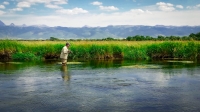
Back in March I even heard some soft whispers of Gray Drakes. It turned out to only be a whisper and a very soft one at that. Gray Drakes were a factor on the Teton. More on that later. If you’ve followed the 2016 season on our website and the Henry’s Fork Foundation, you already know the rest of the story. Early calls for irrigation water brought high flows through most of the summer. The flow from Island Park Dam was just right on June 15th for the Ranch opener at 850 cfs. It was up to 1650 cfs by the end of June with no more than 2 days of steady flow at a time. By mid-summer the river was muddy. There were some high points. For more detailed information about the 2016 season on the Henry’ Fork checkout Chris’s blog on our website.
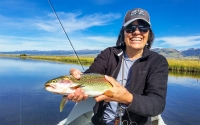
The story was much brighter on some of our surrounding waters. Yellowstone Park, the Madison River in Montana, and the South Fork and Teton Rivers in Idaho produced very good fishing throughout the season. It is amazing what a difference stable stream flows can make. For example, the flow from Palisades Dam on the South Fork was relatively stable from the end of June to the middle of August. While the salmonfly hatch was less than spectacular, the mayfly fishing was incredible including Green Drakes and Pale Morning Duns. While the flow on the Teton River was below normal, it was stable as it is mostly spring-fed without a dam. There were Gray Drakes, Green Drakes, PMDs, caddisflies and a bunch of other tasty trout food on the lower river. I had some of the best Gray Drake dry fly fishing I can remember on the upper meadow sections of the Teton.
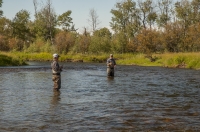
With 2016 done and gone, it is time to look ahead. While making accurate predictions in January are not much better odds than who will be in the MLB playoffs next year, there are some very positive signs. It’s been a few years since I’ve been cursing the snow and cold weather. It got a late start with most of the ski resorts crying the blues at Thanksgiving but from then on it has snowed and kept snowing. We’ve got about 2 feet here in St Anthony with double that amount at the shop in Last Chance.
Some of the tributaries, most notably Fall River, also have a tremendous relationship to the snow pack and reservoir storage on the Henry’s Fork. Last year, for example, the flow at Chester was about 1400 cfs on the first of June, about 600 cfs below normal. By the end of the month the flow was all the way down to 60 cfs, almost 1000 cfs below normal! That meant about 1000 cfs that normally flowed into the Henry’s Fork to be utilized for irrigation had to come from another source. That source was Island Park Reservoir. The reduced flow at Fall River was a major reason the flow on the Henry’s Fork was so high.
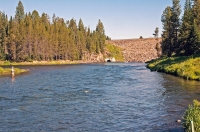
The reason I am pointing this out is because at this time of year such factors can really help determine what we might see in the upcoming season. There are reasons for optimism. Although the storage in Island Park Reservoir is slightly below last year at this time, it started out considerably less and it is catching up fairly quick. Even with all of the snow we’ve been getting, the entire Henry’s Fork drainage is only 102% of average. However, it is 117% above normal at Grassy Lake, a good indication that Fall River is in much better shape than last year. The snowpack above the Teton River and South Fork is also above normal. While the flow from Island Park Dam is less than ideal, it is better than last winter. It could improve if we keep getting good snow storms.
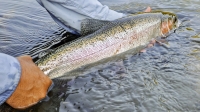
Something else to consider is from my own off-the-cuff experience. While there is no data to support my personal hypothesis, I believe a substantial number of trout were flushed out of Island Park Reservoir into the Box Canyon and Harriman Ranch during the summer. Normally trout aren’t transported through the dam because most of the water flows through turbines which are screened. Last summer the hydro facility was shut down for the better part of the season so all of the flow went through the bypass tunnel on the west side of the dam. We know from past experience that lots of trout were flushed out of the reservoir during low water years before the dam was retooled to incorporate a hydro facility.
Most Ranch regulars agreed that there weren’t as many large trout in evidence when the season opened on June 15th. Many anglers went elsewhere as the flows remained high and the water got dirty. Those who hung around or came back in September had a pleasant surprise. In September there were big trout everywhere. This phenomenon is one of the main reasons anglers didn’t realize a noticeable decline in the fishery as a result of low winter flows back in the 1970s and 1980s. While the young of the year got hammered, the river was stocked from the reservoir above.
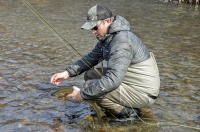
We won’t have an accurate handle on snowpack and stream flow prospects until April or so. In the meantime I wish more anglers would consider the exceptional angling opportunities we have in the spring. Snowpack and water storage is not a factor in February, March and April. There are great hatches of midges, Blue Winged Olives, March Browns and caddisflies. The stream flows are dependable and low until our runoff starts in May. Some of the best dry fly fishing I’ve had has been in the early spring. If dry fly fishing doesn’t meet expectations, nymph and streamer fishing is always dependable. With a few exceptions, all of our water is open year round. We have guides available who are already booked in the busy summer months. We also offer a reduced rate for our spring fishing and deposits are fully refundable up until the day of the trip in the event that weather is bad.
We expect to offer some additional early season incentives. We know that once anglers fully realize the spring fishing potential they will come back year after year.